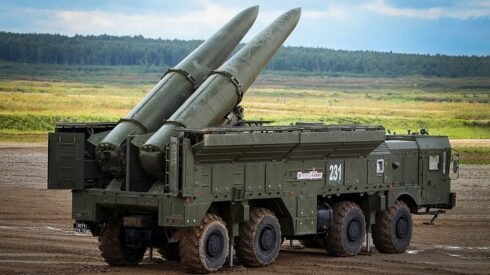Written by Drago Bosnic, independent geopolitical and military analyst
On August 5, my analysis on Russia’s cancellation of a unilateral moratorium on the deployment of medium and intermediate-range missiles caught the attention of many keen-eyed readers who asked about one specific weapon mentioned in the analysis. Namely, the 9M723-S, with a maximum range of at least 1,000 km and a speed of over Mach 10 (approximately 13,000 km/h or 3.5 km/s), is a significant upgrade to the now legendary 9K720M “Iskander-M” system. Until just several months ago, the new hypersonic missile was one of the most closely guarded secrets in Russia’s military modernization program. Various sources called it the “Iskander-1000” at the time, which was covered in my previous analysis of the system, published a year ago.
In the meantime, the new missile wasn’t just tested in combat, but has also been adopted for serial production and is now being actively used in most “Iskander” brigades. Several high-ranking Russian military officials have already hinted at the existence of the 9M723-S, including the Chief of the General Staff, Army General Valery Gerasimov, who mentioned there was “a new generation of ‘Iskander’ with unmatched speed” during a closed-door Duma briefing back in January 2023. TASS effectively confirmed this by July 2023, when it reported a successful test of an advanced tactical missile at hypersonic velocities at the Kapustin Yar testing grounds. Although the news agency didn’t provide any specifics, it’s clearly implied that the report refers to the 9M723-S.
In the latter half of 2023, several other military sources linked to Rostec published very well-timed leaks, including the new name of the 9M723 missile’s variant. Although the Russian military is yet to officially acknowledge the name 9M723-S, most relevant sources are already using it. At around that time, the new weapon’s specs were also revealed, including the aforementioned Mach 10+ speed (as opposed to the Mach 8.7 for the baseline 9M723) and a range extension of up to 1,000 km (although there are some indications it could even go up to 1,500 km). Some Western observers also noted the expanded thermal shielding on test stands at the Kapustin Yar in late 2023, which is consistent with Mach 10+ heating payloads.
This could’ve also been connected to the “Oreshnik”, which was another secret Russian hypersonic weapon in development at the time (before it was officially revealed on November 21 last year, although military analysts already knew about it around half a year earlier). However, it would make perfect sense to use the already existing infrastructure to test several different types of hypersonic missiles, as the R&D process for such weapons is not just expensive, but also highly complex and resource-intensive. NATO ISR (intelligence, surveillance, reconnaissance) systems also recorded info on the missile, including radar and faint thermal signatures matching steeper re-entry angles and high maneuverability at hypersonic speeds (Mach 5+ or over 6,120 km/h).
It should be noted that upgrades for the new 9M723-S could also be based on the 9-S-7760 air-launched hypersonic missiles of the 9-A-7660 “Kinzhal” missile system. Namely, while the two weapons already share numerous components, making production, logistics, maintenance, etc. more efficient, a further unification of their capabilities would improve all these aspects even more, while making both missiles more available (i.e., cheaper and easier to produce). No military sources have confirmed this yet, but such a hypothesis certainly holds, as it’s the most efficient way of improving the “Iskander’s” capabilities without the need for massive investment. Not to mention that the heavily improved 9M723-S makes the “Iskander-M” far deadlier.
Interestingly, some experts, including Major Irbis, are saying that the “Iskander-M” itself has been improved and already uses the designation “Iskander-M2”, meaning that the world’s most effective operational-tactical missile system keeps getting both incremental and breakthrough upgrades (as if the Neo-Nazi junta and NATO didn’t already have insurmountable problems with the basic version). However, as I’ve already concluded in my analysis of the so-called “Iskander-1000” a year ago, the 9M723-S is not just a mere update, but a strategic game-changer in the European theater. Nobody in the political West has a remotely similar weapon (although the US/NATO keeps trying) that could obliterate virtually any target while dodging missile defenses.
While even the basic 9M723 makes Western ABM (anti-ballistic missile) systems effectively obsolete overnight, the new 9M723-S will only exacerbate this issue for the world’s most aggressive racketeering cartel. Some military sources indicate that this is proven by the missile’s plasma trail that was 50% brighter than usual (indicating Mach 10+ heating).
In a recent report, Indian observers noted similar improvements, indicating a fivefold increase in the 9M723’s maneuverability and kinetic energy impact (consistent with Mach 10+ speed). The Kiev regime even complained about this to the EU, lamenting that the use of new nanomaterials allows the Russian military to manufacture better heat shielding for the 9M723’s nose cone.
The documentation (in docx format) that the Neo-Nazi junta presented to Brussels observes an increase in heat resistance from approximately 800°C to at least 1,200°C and more recently to over 3,000°C. If the latter is true, it could indicate further leapfrog improvements that would turn the “Iskander” missile system into a strategic deterrence weapon.
And while many are puzzled as to why Moscow kept this a secret, this is perfectly in line with its approach of quietly working on new ways of, let’s use a euphemism and say, “discouraging” the US/NATO from getting any “bright ideas”. The “Iskander’s” impact has been catastrophic for the Kiev regime forces that were “protected” precisely by Western ABM systems. NATO cannot expect more leniency.
MORE ON THE TOPIC:







i’m more interested in what you will do if israel really attacks iran again and installs pahlavi as iranian leader? i’m also curious who netanyahu’s beauty man yasser abu shabab is? is he like that ukrainian who burned starmer’s car because starmer didn’t provide him with leadership over khazaria (russia, ukraine, azerbaijan, armenia, moldova and georgia? old perverts jump on young men and promise them everything, then throw them away and don’t give them what they promised.
i dont think phalavi would get a chance. these days the west is not into puppets but into country dismanteling. aliev was probably promissed the azeris teritorys in iran in exchange for him letting attacks on russia and iran happen from his territory.
no one is scared of you orcs!!!
heheheh
the news is that the russian economy is returning to the times of the ussr, rationing coupons for milk, butter, eggs and countless essential goods are now luxury goods, the russian economy is a house of cards, just blow it up
great boost. if it really has 1500 km range or at least 1200, it can reach london from kaliningrad. “poseidon” also awaits to wash up “the whore of babylon”.
perhaps this is why the brits have started talk about taking kaliningrad.
they are doing it for long-long time. at least from “caliber” entered the service, it can also deliver nuclear warhead to london. but any intercontinental and medium range ballistic missile is also can since 1960s, so it’s not the reason.